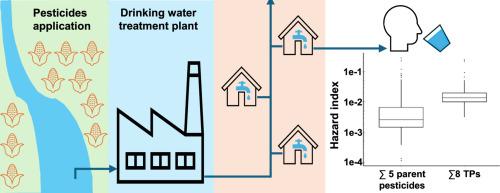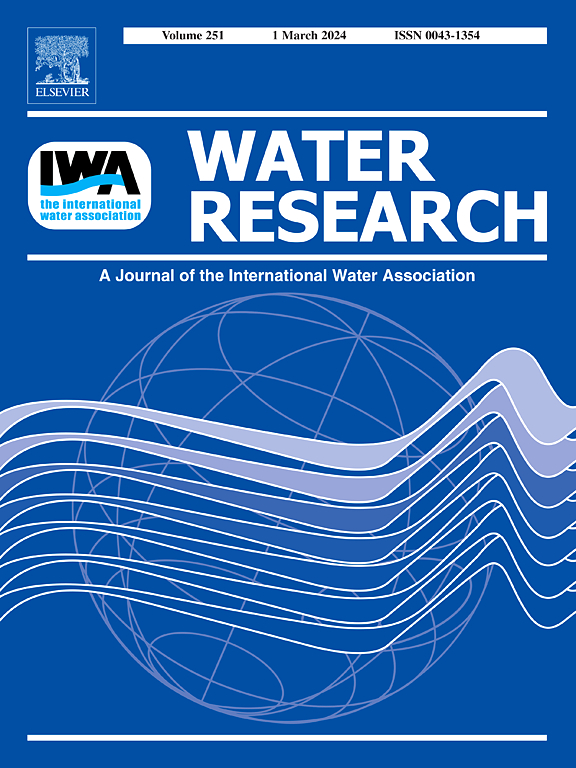Temporal trends of 46 pesticides and 8 transformation products in surface and drinking water in Québec, Canada (2021–2023): Potential higher health risks of transformation products than parent pesticides
IF 11.4
1区 环境科学与生态学
Q1 ENGINEERING, ENVIRONMENTAL
引用次数: 0
Abstract
The objective of the present study was to investigate the temporal trends of 46 pesticides and 8 transformation products (TPs) in the surface water of Québec and assess their associated health risks posed through drinking water consumption. Surface and drinking water were sampled twice per week at a drinking water treatment plant (DWTP) from 2021 to 2023 (838 days). Pesticide and TPs concentrations were analysed using ultra-high-performance liquid chromatography coupled with mass spectrometry. The data were used to evaluate temporal variations of pesticides and TPs at the source, their removal in DWTPs, their human exposure via drinking water, and the associated health risks. The results showed that peak concentrations of most pesticides and their TPs in surface water occurred in June and July, and some TPs (such as metolachlor ethanesulfonic acid, metolachlor oxanilic acid, and desethylatrazine) exhibited higher concentrations than their parent compounds in surface water. Post conventional treatment analysis revealed no significant decrease in the total concentrations of target pesticides and TPs in drinking water. Notably, 11 pesticides (such as atrazine, mecoprop) and 1 TP (desisopropylatrazine) showed higher concentration in drinking water than in surface water. The hazard index (HI) was up to 18 times higher in summer peak periods than the annual average. Finally, TPs exhibited HI 1.4 to 144 times higher than corresponding parent compounds. This study was the first to assess health risks of TPs versus parent pesticides in drinking water through long-term sampling, highlighting the urgent need for further TPs regulation in drinking water.

求助全文
约1分钟内获得全文
求助全文
来源期刊

Water Research
环境科学-工程:环境
CiteScore
20.80
自引率
9.40%
发文量
1307
审稿时长
38 days
期刊介绍:
Water Research, along with its open access companion journal Water Research X, serves as a platform for publishing original research papers covering various aspects of the science and technology related to the anthropogenic water cycle, water quality, and its management worldwide. The audience targeted by the journal comprises biologists, chemical engineers, chemists, civil engineers, environmental engineers, limnologists, and microbiologists. The scope of the journal include:
•Treatment processes for water and wastewaters (municipal, agricultural, industrial, and on-site treatment), including resource recovery and residuals management;
•Urban hydrology including sewer systems, stormwater management, and green infrastructure;
•Drinking water treatment and distribution;
•Potable and non-potable water reuse;
•Sanitation, public health, and risk assessment;
•Anaerobic digestion, solid and hazardous waste management, including source characterization and the effects and control of leachates and gaseous emissions;
•Contaminants (chemical, microbial, anthropogenic particles such as nanoparticles or microplastics) and related water quality sensing, monitoring, fate, and assessment;
•Anthropogenic impacts on inland, tidal, coastal and urban waters, focusing on surface and ground waters, and point and non-point sources of pollution;
•Environmental restoration, linked to surface water, groundwater and groundwater remediation;
•Analysis of the interfaces between sediments and water, and between water and atmosphere, focusing specifically on anthropogenic impacts;
•Mathematical modelling, systems analysis, machine learning, and beneficial use of big data related to the anthropogenic water cycle;
•Socio-economic, policy, and regulations studies.
 求助内容:
求助内容: 应助结果提醒方式:
应助结果提醒方式:


